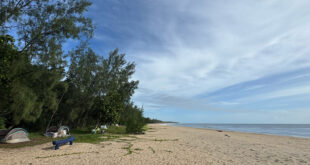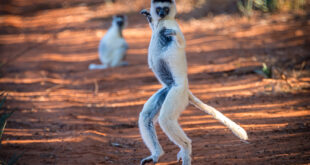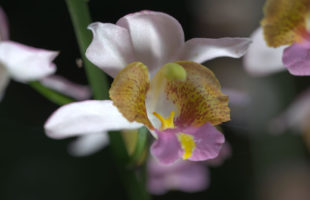Mitsinjo:
Mitsinjo means as much as “looking ahead” or “planning the future”.
Location:
The reserve is located close to the village Andasibe in eastern Madagascar, around 140 km away from the capital Antananarivo, in the region Alaotra-Mangoro. You drive approximately four hours on RN2, which is not in the best condition, and then change direction at a well-signed junction.
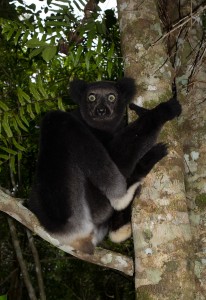
Information about the reserve:
Mistinjo reserve is led by the identically named, communally led organization. In 1999, thirteen Malagasy villagers founded both. They wanted to take the future and conservation of their rainforests into their own hands. In 2003, the first big success was the take-over and expansion of the forest station in Analamazaotra. This station had existed since the beginning of the 20th century yet and now came into life again. The house roofed with palm leaves is only 200 m away from the entry of a part of the state-run national park Andasibe-Mantadia. Behind the forest station, there is 7 km² of rainforest. A part of the area consists of acreage formerly used for slash-and-burn agriculture, thus Mitsinjo founded several tree nurseries for reforestation. Up to date, two tree nurseries are working and producing about 40.000 seedlings from 125 different endemic Malagasy trees per year. For 30.000 Ariary, you can choose your own tree seedling there and plant it directly into the reforestation area – just ask at the forest station nearby the street!
A spacious swampland called Torotorofotsy close to Menalamba, northwest of Andasibe belongs also to the reserve. It hosts on almost 100 km² an enormous richness of amphibians, rare plants, and birds, as well as the greater bamboo lemur (Prolemur simus). In 2005, Torotorofotsy was declared a Ramsar site, which means an area that is seen as especially worth protecting by the “International Convention on Wetlands”, signed in the city of Ramsar (Iran).
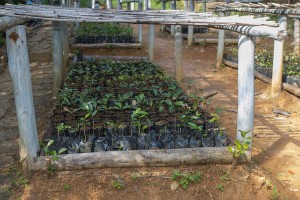
Furthermore, science has always been high on Mitsinjo’s agenda: In 2011, the first research and captive breeding center for amphibians in Madagascar opened its doors here. Andasibe is known for its high diversity in frog species. More than one hundred species occur in the fascinating fauna of the reserve and the area around. Most of them can only be found in Madagascar. With the help of international supporters (among them the Durrell Wildlife Conservation Trust, the Amphibian Ark, or the Association of Zoo and Aquariums), a breeding station for amphibians, insect breeding facilities for feeders, and a quarantine station were established in the reserve. Seven species inhabit the breeding station and are being cared for today. Over the intervening years, much new knowledge about conservation and especially breeding of highly threatened amphibian species like the Golden Mantella (Mantella aurantiaca) has been won and published scientifically.
But Mitsinjo does not only care about the protection of their own rainforest and its inhabitants. They also inform local people about malaria and AIDS and do a mass of little things to make conservation and ecotourism reach Malagasy children and adults of the area. The reserve works together with eight schools of the region, supports them with free visits, does projects about conservation with the children, and teaches the kids the importance of their home country’s nature. Today, 42 people work for Mitsinjo, among them 19 trained local guides. Only two employers are not of Malagasy origin.
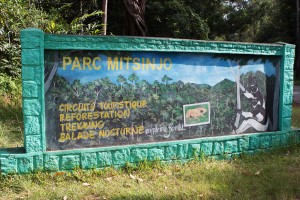
You can visit Mitsinjo reserve every day from 07 to 16 o’clock. At the forest station of Analamazaotra, you will get a local guide and pay the entrance fees of 35.000 to 50.000 Ariary per person (approximately 11 to 18 €, depending on the length of your stay and route). Everyone will surely find a matching hiking trail among the paths of two to eight kilometers in length.
Climate:
As in neighboured Andasibe-Mantadia national park and V.O.I.M.M.A. reserve, the climate is humid all year round in Mitsinjo. During the daytime, it is usually comfortably warm, but at night temperatures may drop heavily.
Infrastructure:
As one of the most visited areas of Madagascar, Andasibe has an extraordinary infrastructure. Only a few kilometers away from Mitsinjo, you can find hotels for practically all incomes. There is a large number of good restaurants and most offer even Wifi today. Travelers who like to camp in the rainforest can use a small campground with water (no electricity) for a small fee. Mitsinjo itself also has a small souvenir shop with locally handcrafted products.
Flora & Fauna:
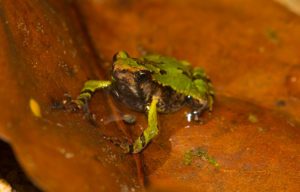
Mitsinjo’s biggest treasure is the diversity of frogs. Andasibe is known for its extreme richness in frog species. More than one hundred species can be found in the fascinating fauna in and around the reserve. Almost none occur outside Madagascar, among them common species such as Boophis pyrrhus, Boophis luteus, or Boophis viridis, but also rare species such as Mantella crocea. However, Mistinjo is not only famous for its amphibians: The forest is home to Madagascar’s largest lemur, the Indri. Diademed sifakas and wooly lemurs are only a part of the various rare animals that you can watch here. Concerning reptiles, the reserve has a large amount of chameleons Calumma brevicorne, smaller Calumma nasutum, and Calumma emelinae and the bright colored Calumma parsonii cristifer, but also leaf-tailed geckos, snakes such as the Malagasy Tree Boa, and other beauties of nature.
Since Mitsinjo is a communally led reserve and not a national park, you can do nocturnals there, too. Let the magic of the night happen and hear all the countless frogs calling in the dark!
- Web blog of Association Mitsinjo
- Video about the organization’s work
 MADAMAGAZINE Your Magazine about Madagascar
MADAMAGAZINE Your Magazine about Madagascar











